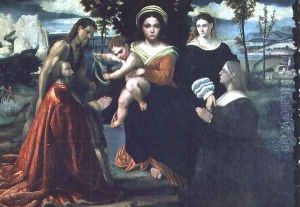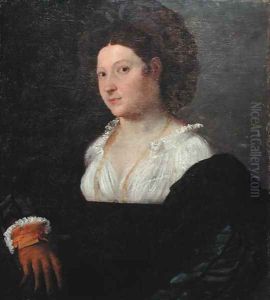Francesco (Il Moro) Torbido Paintings
Francesco Torbido, also known as Il Moro due to his dark complexion or possibly his Moorish attire, was an Italian painter of the Renaissance, born in Verona in 1486. His initial artistic training was under Liberale da Verona, a prominent painter of the time, which grounded Torbido in the rich traditions of the Veronese school of painting. However, his style and technique were significantly influenced by his subsequent studies in Venice, where he became a pupil of Giorgione, one of the most enigmatic and influential figures of the Venetian Renaissance. This tutelage under Giorgione left a lasting impact on Torbido's work, evident in his sophisticated use of color and light, as well as the poetic atmosphere he infused into his paintings.
Torbido's career flourished upon his return to Verona, where he became known for his religious compositions, portraits, and frescoes. His works are characterized by their vibrant colors, meticulous attention to detail, and the emotional depth of the figures depicted. Among his notable works are the frescoes in the Cathedral of Verona and the church of San Bernardino, where his mastery in handling large-scale compositions and his ability to convey spiritual themes through art are prominently displayed. Torbido's portraits also gained acclaim for their psychological depth and realism, marking him as a significant figure in the development of portrait painting in Northern Italy.
Despite his achievements, Francesco Torbido remains a somewhat obscure figure in art history, overshadowed by the luminaries of the Italian Renaissance. However, his contributions to the Venetian and Veronese schools of painting have been recognized by art historians, who note his role in the transition between the early and high Renaissance periods. His blending of Venetian colorism with the detailed naturalism of the Veronese tradition represents a unique bridge in Italian art, reflecting the broader cultural and artistic exchanges of his time. Torbido died in Verona in 1562, leaving behind a legacy that, while not as widely celebrated as that of his contemporaries, is rich in its contribution to the Renaissance movement.

